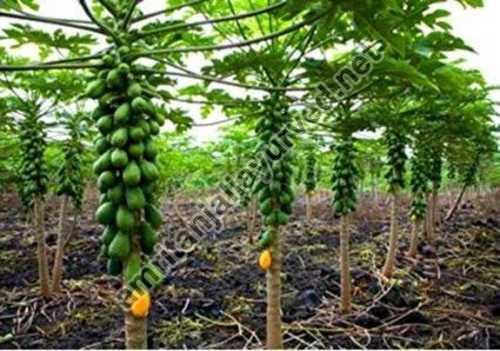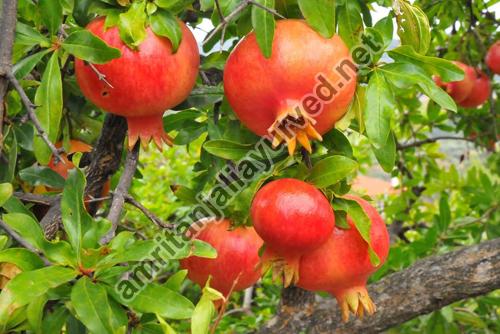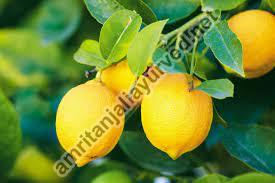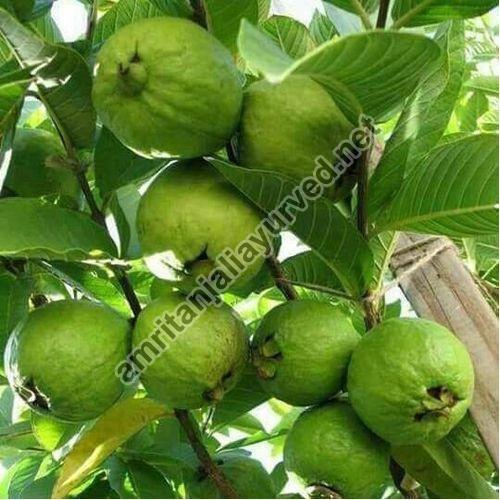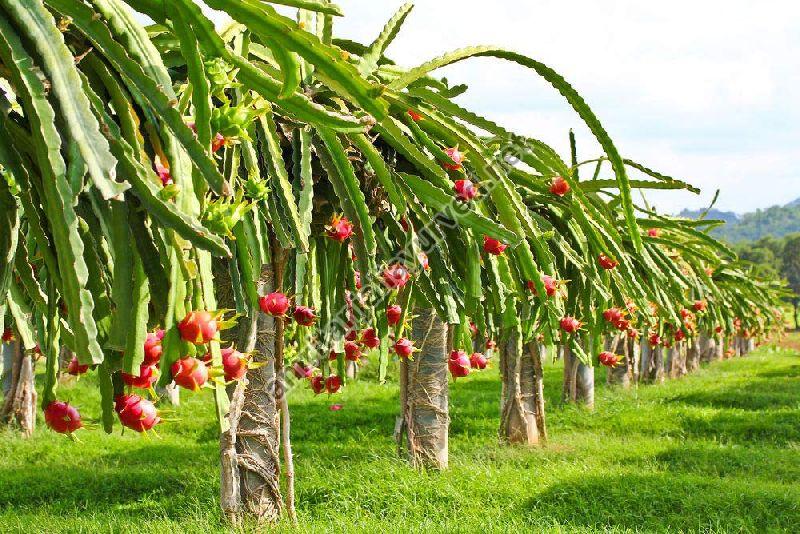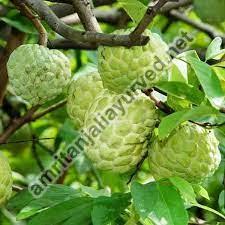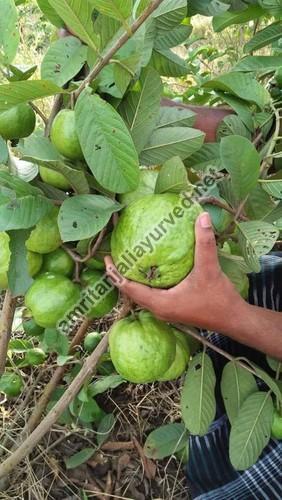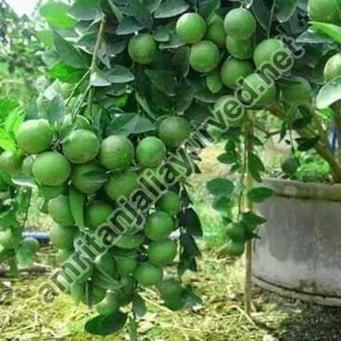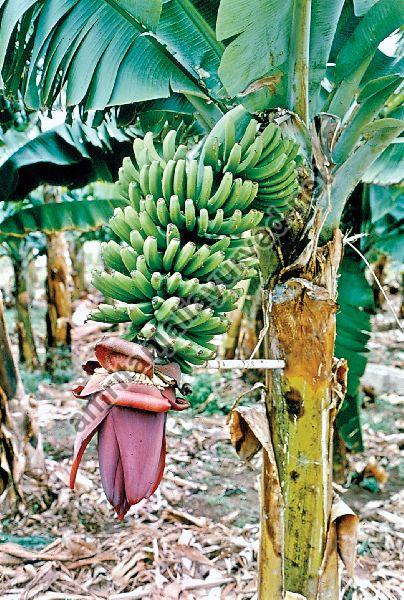Saheli Nagar, Udaipur, Rajasthan
- GST NO. : 08AAOCA7653C1ZJ
Horticulture
Leading Manufacturers, Exporters, Wholesaler, Retailer and Trader of Papaya Plant, Anjeer Plant, Pomegranate Plant, Lemon Plant, Guava Plant, Dragon Fruit Plant, Apple Ber Plant, Custard Apple Plant, Thai Guava Plant, Thai Lemon Plant and Banana Plant from Udaipur.
| Business Type | Manufacturer, Exporter, Supplier, Retailer, Wholesaler |
| Type | Papaya Plant |
| Cultivation Type | Organic |
| Color | Green |
| Family | Caricaceae |
| Scientific Name | Carica Papaya L. |
| Origin | American Tropical Lowlands |
Preferred Buyer From
| Location | Worldwide |
PAPYA CULTIVATION
Papaya (Carica papaya L.) Caricaceae
Soil and climate
It is a tropical fruit and grows well in regions where summer temperature ranges from 35°C - 38°C. Tolerates frost and comes up to an elevation of 1200 m above mean sea level. Well drained soils of uniform texture are highly preferable to avoid the collar rot disease.
Sowing
500 g of seeds is required for planting one ha. June-September is the best season for planting. Avoid planting in rainy season.
Nursery
Treat the seeds with Captan @ 2 g/kg of seeds. Dibble four seeds in polythene bags in depth not exceeding one cm. Keep the polythene bags in partial shade. Watering can be done with the help of rose can. Seedlings will be ready in about 60 days.
Planting
Plant the seedlings at 1.8 m either ways in pits of 45 cm x 45 cm x 45 cm size.
Irrigation
Irrigate copiously after planting. Irrigate the field once in a week.
Application of fertilizers
Apply FYM 10 Kg/plant as basal and 50 g in each of N, P and K per plant at bi-monthly intervals from the third month of planting after removing unwanted sex forms. Apply 20 g in each of Azospirillum and Phosphobacterium at planting again six months after planting.
Fertigation technique
Apply 10 litres of water per day + 13.5 g urea and 10.5 g muriate of potash/ week through drip irrigation and soil application of super phosphate 300g per plant at bimonthly intervals starting from 3-4 months after planting immediately after thinning of plants is recommended.
After cultivation
Male trees should be removed after the emergence of inflorescence maintaining one male tree for every 20 female trees for proper fruitset. In each pit only one vigorously growing female/hermaphrodite tree should be retained and other plants should be removed. In gynodioecious type like (Co 3 & Co 7) keep one hermophrodite type/pit and remove female trees.
Micronutrients
Spray ZnSO4 0.5% + H2BO3 0.1% during 4th and 8th month to increase growth and yield characters.
Plant protection
Nematodes
To control the nematode infestation in nursery, apply Carbofuran 3 G @ 1 g/polythene bag after germination.
Diseases
Papaya ring spot virus
Grow maize as catch crop for vectors. Spray insecticides to control the vectors. Micronutrient spray at fortnight intervals.
Root rot and wilt
In water stagnated areas root-rot may appear easily. It is advisable to drench the soil with 0.1 % Methoxyethyl mercuric chloride or 1 % Bordeaux mixture or Metalaxyl 0.2%, 2 or 4 times at fortnightly intervals. Good drainage is important to avoid the spread of disease.
Crop duration: 18 months.
Fruits should be picked at colour break stage.
We provide Agro technology and Agribusiness consultancy through better utilization of your resources, value of your money, independent consultancy, cost effective, profitable solutions and complete satisfaction without any deviation.
Material Available
- PAPYA PLANT
- PAPYA SEED
- PAPYA FRUIT
- PAPYA DRY LEAF
- PAPYA DRY ROOT
With a proper network of buyers with us, we are able to provide returns of the farmers/cultivators who purchase the planting material from us and do farming as per our instructions. The crop/crops under buy back agreement are provided with targeted requirements. We are making farming a business which gives assured profits.
Persons interested in farming with buy back agreement will be entertained only on prior appointment basis.+91-9799931200
| Business Type | Manufacturer, Exporter, Supplier, Retailer, Wholesaler |
| Plant Size | 1-10 Feet |
| Temperature | 45 degrees C |
| Fruit Type | Anjeer |
| Origin | Indian |
| Color | Green |
| Soil Specific | Acidic |
Preferred Buyer From
| Location | Worldwide |
ANJEER CULTIVATION
Fig (Ficus carica), is one of the ancient fruits known to mankind which also finds its mention in the Bible. It is reported to be under cultivation from 3000-2000 BC in the eastern Mediterranean region.
The fig fruit is unique. Unlike most 'fruit' in which the structure is matured ovary tissue, the fig's edible structure is actually a stem tissue. The fig fruit is an inverted flower with both male and female flower parts enclosed in stem tissue, botanically known as a syconium.
At maturity, the interior of the fig contains only the remains of the flower structure, including the small gritty structures commonly called 'seed', which are the unfertilized ovaries that had failed to develop. They impart resin like flavour associated with fig.
Fruits are consumed fresh as well as in the dried form.
Fresh Figs are delicious and nutritious as they are rich in calorie, protein, calcium and iron. Fig has nutritive index of 11, as against 9 for apple and 6 for raisin. The bulk of the fruit (about 80%) is consumed in the dried form. The fruit is also credited with laxative and medicinal properties and is being applied on boils and for other skin infections
.
Types of Fig
Figs have been grouped into four types depending on the sex of the flower and the method of pollination.
Common Fig or Edible Fig- Individual flowers are long styled pistillate and fruits develop parthenocarpically. Popular cultivars include - Poona, Conardia, Mission Kadota, and Brown Turkey.
Smyrna Fig - Fruit develops only on Pollination by male flowers of Capri fig through the Fig wasp. Most important variety is 'calimyrna'.
Capri Fig or Wild Fig - Short styled Pistillate flowers and functional staminate flowers, Capri fig are not edible but grown because they harbour fig wasp (Blastophaga psenes), which is necessary for pollination and setting fruits.
San Pedro Fig - It is an intermediate type where the first crop (known as Breba) is Parthenocarpic, while the 2nd crop (main) requires pollination like Smyrna type.
Global and National Scenario Fig is a moderately important fruit crop with an annual estimated global production of one million tons of fruit of which about 30% is produced by Turkey. The other major producers are Egypt, Morocco, Greece, California, Italy, Algeria, Syria and Tunisia.
In India, fig is considered to be a minor fruit crop and the commercial cultivation of common (edible) fig is mostly confined to Western Parts of Maharashtra, Gujarat, Uttar Pradesh (Lucknow & Saharanpur) Karnataka (Bellary, Chitradurga & Srirangapatna) and Tamilnadu (Coimbatore).
Package of Practices
Climate
Fig being a deciduous and sub tropical tree, prefers areas having arid or semiarid environment, high summer temperature, plenty of sunshine and moderate water. Although the plants can survive temperature as high 45C, the fruit quality deteriorates beyond 39C. Though the mature tree can withstand low temperature up to 40C, it makes good growth when the temperature is above 15 - 21C . The size, shape, colour of the skin and pulp quality are markedly affected by climate. But quality figs are produced in the region with dry climate especially at the time of fruit development and maturity. High humidity coupled with low temperature usually results in fruit splitting and low fruit quality.
Soil
Fig is one of the most salt and drought tolerant crops. It can tolerate a fairly high level of sulphate or chloride salt. Medium to heavy, calcareous, well drained, deep (about 1 m ) soil having pH of 7-8 is ideally suitable cultivation of fig.
Varieties
There are about 20 popular varieties of fig that are being grown in different parts of the world. Some famous varieties of common fig grown in different countries are 'White Adriatic' 'Black Mission', 'Kodota' and 'Conadira' in California; 'Kalamon' in Greece; Sultani in Egypt. The 'Smyrna types' includes popular Turkish cultivar known as 'Saricop' in Turkey and 'Calimyrna' in United States. In India 'Poona' is the most popular cultivar grown for consumption as fresh fruit. Most of the fig grown in Mangalore, Bellary, Coimbatore, Daulatabad, Ganjam, Lucknow and Saharanpur resembles in plant and fruit morphology to that of Poona Fig. Recently, a variety 'Dinkar', an improvement over 'Daulatabad' variety for yield and fruit quality is gaining commercial importance. Some hybrids from California have reportedly performed better over Poona Fig under Mangalore conditions.
Propagation
Fig is propagated by cuttings. Cuttings of about 25 cm in length having 3-6 nodes from the wood of previous season are usually used as planting material.Now-a-days Tissue Culture Plants are also available
.
Planting
Fig is planted in square system of planting at a spacing of 5 x 5 m accommodating about 160 plants per acre. Pits of 0.6 cu.m are dug for planting the cuttings. The planting is generally done during June to September.
Manures and Fertilisers
The year wise requirement of various manures and fertilisers for fig is as under
Recommended fertiliser dosage (kg/tree/year) for Fig
Year FYM Neem Cake Nitrogen Phosphorous Potassium
1 25 0.50 0.060 0.040 0.040
2 25 0.50 0.120 0.080 0.080
3 25 1.00 0.180 0.120 0.120
4 30 1.50 0.240 0.160 0.160
5th year onwards
35 2.00 0.300 0.200 0.200
Irrigation
Fig can sustain heat and drought. However, for commercial production timely irrigation is necessary. Flood irrigation at an interval of 10-12 days during summer is ideal. However, if drip irrigation is adopted 15-20 litres of water/day/plant needs to be provided.
TrainingandPruning
Fig trees are trained initially to a single stem and allowed to grow to a height of about 1m and then it is topped. Light pruning is practiced in Poona Fig after the monsoon is over i.e. in October
.
Plant Protection
The major pests of fig are stem borers, leaf defoliators and fig flies. The fig fly can be controlled by Demecron (0.05% spray). The stem borer is controlled with the application of Phorate granules with Petrol or Kerosene. Important disease of fig is rust which is caused by Cerotelium fici. It can be controlled by dusting with sulphur or spraying with Blitox or Dithane M-45 and Dithane Z-78.
Growth regulator
To promote proper shoot growth and to prevent fruit drop in fig, growth regulators like Gibberellic Acid (GA) @ 30 ml / litre of water is used.
Harvesting and Yield
Though fig starts bearing fruits from the second year, commercial harvesting is done from the third year. The yield increases with increase in canopy size of the tree and stabilizes during eighth year. The economic life of the plant is about 35 years. The harvesting season starts in February - March and is over by May - June. The fruits are harvested in 2-3 day intervals manually. The age wise yield of fig (fruits in kg/per tree) is given in Table
Age wise yield of Fig (kg/tree)
Age of the plant (years) Yield/tree (kg)
3 3
4 6
5 9
6 12
7 15
We provide Agro technology and Agribusiness consultancy through better utilization of your resources, value of your money, independent consultancy, cost effective, profitable solutions and complete satisfaction without any deviation.
Material Available
ANJEER PLANT
ANJEER FRUIT
With a proper network of buyers with us, we are able to provide returns of the farmers/cultivators who purchase the planting material from us and do farming as per our instructions. The crop/crops under buy back agreement are provided with targeted requirements. We are making farming a business which gives assured profits.
Persons interested in farming with buy back agreement will be entertained only on prior appointment basis.+91-9799931200
| Business Type | Manufacturer, Exporter, Supplier, Retailer, Wholesaler |
| Type | Pomegranate Plants |
| Style | Fresh |
| Cultivation Type | Organic |
| Maturity | 100% |
| Feature | Non Harmful |
| Quality | Superior |
Preferred Buyer From
| Location | Worldwide |
POMEGRANATE CULTIVATION
TC Pomegranate Plants is native to the Middle East and South Asia. The Pomegranate Plant is one of the first live cultivated foods in the world. The Pomegranate Plant produces Pomegranate that is high in potassium, vitamin C and antioxidants. Pomegranate is a high value crop.
Pomegranate Farming
Pomegranate (Punica granatum) is an ancient favourite table fruit of tropical and sub-tropical regions of the world. Pomegranate is one of the commercially important fruit crops of India. It is native to Iran (Persia).
Area of Cultivation:
Pomegranate is cultivated commercially only in Maharashtra. Small scale plantations are also seen in Gujarat, Rajasthan, Karnataka, Tamil Nadu, Andhra Pradesh, Uttar Pradesh, Punjab and Haryana.
Climate Requirements:
Pomegranate fruit prefers dry climate for its growth. The tree requires hot and dry climate during fruit development and ripening. Pomegranate tree is deciduous in areas of low winter temperature and an evergreen or partially deciduous in tropical and sub-tropical conditions.
Planting:
Planting is usually done in spring (February-March) and July-August in sub-tropical and tropical regions respectively. Square system of planting is mostly adopted. Planting distance is decided on the basis of soil type and climate.
A spacing of 4-5 m. on marginal and very light soils is recommended. High density planting is adopted in temperate regions. High density planting with a spacing gives 2-2.5 times more yield than that obtained when the normal planting distance of 5 X 5 m.
Irrigation:
Drip irrigation helps to save 44% on irrigation and 64% when sugarcane trash mulch is used. First irrigation is provided in case of mrig bahar crop in the middle of May followed by regular irrigation till the monsoon sets in. Weekly irrigation in summers and that during winters at fortnightly intervals is recommended. The check basin system of irrigation is usually followed.
Plant Protection:
Insect pests mostly observed are fruit borer, mealy bugs, aphids, white fly and fruit sucking moths. Spraying with dimethoate, deltamethrin or malathion etc. depending upon the type of pest infestation has been found to be effective in most cases.
The main diseases reported are leaf spot and fruit rot. Application of Mancozeb (2g./l.) during rainy season in case of the former and application of Kavach (2g./l) and Carbendazim/Thiophanate methyl/Baycor/Benomyl (1g./l.) during September/October in case of the latter has been found to be effective in most cases.
Storage:
Fruits can be stored in cold storage upto 2 months or 10 weeks at a temperature of 50 C. Longer storage should be at 100 C and 95% RH to avoid chilling injury and weight loss.
We provide Agro technology and Agribusiness consultancy through better utilization of your resources, value of your money, independent consultancy, cost effective, profitable solutions and complete satisfaction without any deviation.
Material Available
- POMEGRANATE PLANT
- POMEGRANATE SEEDS
- POMEGRANATE FRUIT
With a proper network of buyers with us, we are able to provide returns of the farmers/cultivators who purchase the planting material from us and do farming as per our instructions. The crop/crops under buy back agreement are provided with targeted requirements. We are making farming a business which gives assured profits.
Persons interested in farming with buy back agreement will be entertained only on prior appointment basis. +91-9799931200
| Business Type | Manufacturer, Exporter, Supplier, Retailer, Wholesaler |
| Size | Large |
| Type | Grafted Lemon Plant |
| Application | For Gardening |
| Cultivation Type | Organic |
| Maturity | 99% |
| Color | Green, Yellow |
| Feature | Longer Shelf Life |
Preferred Buyer From
| Location | Worldwide |
LEMON CULTIVATION
Acid Lime (Citrus aurantifolia (Christm) Swingle)
Rutaceae
Soil and climate
The crop can be cultivated in both Tropical and subtropical climate. It can be grown up to 1000 m above MSL. Deep well drained loamy soils are best suited for the cultivation.
Season
The planting is done from December – February and June – September.
Planting
Healthy seedlings are planted during June to December at 5 to 6 m spacing in 75 cm x 75 cm x 75 cm pits.
Irrigation
Irrigate copiously after planting. After establishment of the crop, irrigation is given at 7 – 10 days interval. Water stagnation should be avoided.
Manures and fertilizers per plant
N is applied in two doses during March and October. FYM, P2O5 and K2O are to be applied in October
Spray Zinc sulphate at the rate of 0.5% (500 g/100 lit of water) thrice in a year (March, July and October) after the emergence of new flushes.
After cultivation
The branches of main stem up to 45 cm from ground level have to be removed. Green leaves @ 30 kg per tree are applied once in 3 months.
Intercropping
Legumes and vegetable crops can be raised during pre-bearing age.
Growth regulator
To increase the fruit set, spray 2, 4 – D @ 20 ppm during flowering stage. For fruit retention, spray 2, 4 – D @ 20 ppm or NAA @ 30 ppm after fruit set (marble size).
Plant protection
Pests
Leaf miner
The pest can be controlled by spraying Dichlorvos 76 WSC @ 1 ml/lit or Dimethoate 30 EC @ 2 ml/lit or Monocrotophos 36 WSC @ 1.5 ml/lit or neem seed kernel extract (NSKE) @ 50g/lit or 3 % neem cake extract or neem oil.
Leaf caterpillar
When the infestation is moderate to severe, Quinalphos25 EC @ 2ml/lit is sprayed to control to control the pest. The larvae can be hand picked and destroyed.
Sucking pests
- White fly : For control, spray Quinalphos 25 EC @ 2 ml/lit
- Black fly : For control, spray Monocrotophos 36 WSC @ 1.5 ml/lit
- Aphids : Spray methyl Demeton 25 EC or Monocrotophos @ 1 ml/lit or neem oil 3ml/lit or Fish oil resin soap 30 g/lit or Quinalphos25 EC 2ml/lit to control the pest.
- Rust mite : For control, spray Dicofol 18.5 EC @ 2.5 ml/lit or Wettable sulphur 50 WP @ 2 g/lit.
Fruit sucking moth
Tinospora weed host have to be destroyed. Bait with fermented molasses plus Malathion 50 EC at the rate of 1 ml/lit can be used for control. Bag the fruits with polythene bags punctured at the bottom. Apply smoke and set up light traps or food lures (pieces of citrus fruits) for control.
Shoot borer
Prune the withered shoots 4 cm below the dried portions and spray Monocrotophos 36 WSC @ 1 ml/lit or Quinalphos25 EC @ 1.5 ml/lit or Carbaryl 50 WP @ 2 g/lit.
Stem borer
The branches containing grubs have to be pruned. Plugging the fresh holes with cotton soaked in Monocrotophos solution mixed @ 5 ml/20 ml of water will also control the pest.
Fruit fly
To control fruit fly, spray Malathion 50 EC @ 1 ml/lit or Fenthion 100 EC @ 1 ml/lit with 1% crude sugar (10 g/lit). Set up bait with Methyl eugenol 0.1% solution mixed with Malathion 50 EC 0.05% between 6 a.m. and 8 a.m.
Use polythene bags fish meal trap containing 5 g of wet fish meal + 1 ml Dichlorvas in cotton. 50 traps are required/ha, fish meal and Dichlorvos soaked cotton have to be renewed once in 20 and 7 days respectively.
Mealy bugs
- Debark the branches and apply methyl parathion paste.
- Use sticky trap on the fruit bearing shoots at a length of 5 cm.
- Use Dichlorvos (0.2%) in combination with fish oil resin soap (25g/lit) as spray or for dipping the fruits for two minutes.
- Single soil application of Phorate 10G @ 50g per tree around the base at the time of pruning is essential.
- Release the predator, Cryptolaemus montrouzieri for controlling the pest.
- Mark the mealy bug infested plants early in the season.
- Follow ant control methods such as destruction of ant holes, red ant nests and skirting of citrus trees after fruit harvest which prevents the ant migration through side branches.
- Release beetles @ 10/tree once the patrolling of the ants on the trunk is stopped.
- Make periodic check during the first fortnight and put dried leaf mulch around the tree trunk 20 days after the release of the beetles to facilitate pupation of the full grown grubs.
- Make one to three releases per annum depending on the mealy bug populations.
Nematodes
Apply Carbofuran 3 G @ 75 g/tree to control citrus nematodes in severe infestations. Apply 20 g Pseudomonas fluorescens formulation per tree at a depth of 15 cm and 50 cm away from the trunk once in four months. Soil application of Phorate @ 2 g followed by drenching with 1 % of Metalaxyl plus Mancozeb 72 WP @ 50 ml/ cutting/ poly bag/ kg of nursery soil is done for controlling citrus decline.
Diseases
Twig blight
Prune dried twigs and spray 3% Copper oxychloride or 0.1% Carbendazim at monthly intervals to reduce the spread of disease.
Scab
Spray 1% Bordeaux mixture to control the disease.
Canker
Immediately after pruning one spray of Copper oxychloride (COC) 0.3% is done followed by 4 sprayings with Streptocyclin100 ppm + COC 1.5 kg/ha at monthly intervals.
Tristeza virus
Remove the infected trees and destroy. Spray Methyl demeton 25 EC or Monocrotophos @ 1 ml/lit to control the aphids which spread the disease. Use pre-immunized acid lime seedlings for planting.
Harvest
The crop starts bearing from 3rd year after planting.
Post harvest treatment
Treating the fruits with 4% wax emulsion followed by pre-packing in 200 gauge polythene bags with 1 % ventilation improves the shelf life for more than 10 days.
Yield
The crop yields about 25 t/ha/year.
We provide Agro technology and Agribusiness consultancy through better utilization of your resources, value of your money, independent consultancy, cost effective, profitable solutions and complete satisfaction without any deviation.
Material Available
- LEMON PLANT
- LEMON SEEDS
- LEMON FRUIT
- LEMON DRY FRUIT
- LEMON JUICE
- LEMONE PEAL
With a proper network of buyers with us, we are able to provide returns of the farmers/cultivators who purchase the planting material from us and do farming as per our instructions. The crop/crops under buy back agreement are provided with targeted requirements. We are making farming a business which gives assured profits.
Persons interested in farming with buy back agreement will be entertained only on prior appointment basis.+91-9799931200
| Business Type | Manufacturer, Exporter, Supplier, Retailer, Wholesaler |
| Type | Guava Plant |
| Application | Guava Fruits |
| Cultivation Type | Organic |
| Color | Green |
| Feature | Disease Free |
| Benefits | Gives Tasty Fruits |
Preferred Buyer From
| Location | Worldwide |
Guava (Psidium guajava) is valued for its delectable taste and aromas a cheap nutritious fruit with a wide adaptability to diverse climatic and soil conditions, guava is an ideal crop to grow in developing countries The guava tree can easily be recognizable for its smooth, thin, brown bark that flakes off, exposing a greenish layer underneath. Guava is used to produce jams, jellies, and juices commercially. Guava may be eaten raw or cooked. Guavas are an excellent source of vitamin C and also contain iron calcium, and phosphorus.
Soil and climate
Guava grows well both in wet and dry regions but it does better under irrigation in the dry tracts. It can be grown upto 1000 m altitude. Well drained soils are the best suited for guava cultivation. It can tolerate salinity and alkalinity. In saline soils add 3 Kg Gypsum/plant during planting and once in three years after planting to overcome the problem.
Planting material
LaSeason of planting
The planting is distributed from June - December.
Spacing
A spacing 5 - 6m in either way is generally followed.
Planting
Plant the layers with the ball of earth in the centre of pit of 45 cm x 45 cm x 45 cm size filled with FYM 10 Kg neem cake 1 Kg and top soil
Irrigation
Irrigate copiously immediately after planting, again on third day and afterwards once in 10 days or as and when necessary.
Manures and fertilizers
FYM 50 Kg and one Kg in each of N, P and K per tree in two split doses during March and October should be applied. To increase the yield, spray Urea 1 % + Zinc sulphate 0.5% twice a year during March and October. To correct the boron deficiency (reduction in size of leaves and fruit cracking and hardening) spray 0.3% borax during flowering and fruit set stage.
Micronutrients spray for controlling bronzing of leaves
A combined spray should be given containing ZnSO4, MgSO4 and MnSo4 @ 0.5% and CuSO4 and FeSO4 @ 0.25 % plus Teepol @ 1ml per 5 lit of solution on various stages as follows:
- New flush
- Flowering
- One month after
- Fruit set
Intercropping
Legumes and short duration vegetable crops may be raised during pre-bearing stage.
Aftercultivation
Pruning of past season’s terminal growth to a length of 10-15 cm is to be done during September-October and February – March to encourage more laterals. The erect growing branches are to be bent by tying on to pegs driven on the ground. Old unproductive but healthy trees can be rejuvenated may be either pollarded or cut back to 75 cm from ground level or dehorned by cutting the secondary branches at a distance of 75 cm from their origin.
Plant protection
Pests
Tea mosquito bug
Spray Quinalphos 25 EC at the rate of 2 ml/lit or Malathion 50 EC at the rate of 1 ml/lit or Monocrotophos 36 WSC @ 2ml/lit or neem oil 3 %. Spraying should be done in early mornings or late evenings, at least four times at 21 days interval during fruiting season.
Aphids
Spray Monocrotophos 36 WSC @ 1ml/lit or Dimethoate 30 EC @ 2 ml/lit to control aphids.
Mealy bug
The mealy bugs can be controlled by spraying Triazophos @ 2ml/lit + neem oil 5 ml or phosalone 0.05% + neem oil 5 ml. Release of Cryptolaemus montrouzieri beetles (Coccinellid beetles) @ 10 beetles /tree is also recommended.
Fruit fly
Spray Quinalphos 25 EC or Malathion 50 EC @ 1 ml/lit four times at 15 days interval. Use polythene bags fish meal trap with 5 gm of wet fish meal + 1 ml. dichlorvos in cotton. 50 traps are required/ha, fish meal and Dichlorvos soaked cotton are to be renewed once in 20 and 7 days respectively.
Safe waiting period
For Monocrotophos 36 WSC-10 days and for Malathion 50 EC – 9 days.
Diseases
Red rust
Spray Copper oxy chloride 2.5 g /lit or Bordeaux mixture 0.6 % or Wettable sulphur 2 g/lit to control red rust.
Harvest
Layers come to bearing in 2 - 3 years. The first crop can be harvested during February – July and the second one during September – January.
Yield
The crop yields about 25 t/ha.yers are used as planting material.
With a proper network of buyers with us, we are able to provide returns of the farmers/cultivators who purchase the planting material from us and do farming as per our instructions. The crop/crops under buy back agreement are provided with targeted requirements. We are making farming a business which gives assured profits.
Persons interested in farming with buy back agreement will be entertained only on prior appointment basis. +91-9799931200
| Business Type | Manufacturer, Exporter, Supplier, Retailer, Wholesaler |
| Cultivation Type | Natural |
| Other Necessities | Full Sun Exposure |
| Soil Specific | Alkaline |
| Growing Age | 10-15 Years |
| Place Of Origin | India |
Preferred Buyer From
| Location | Worldwide |
Dragon fruit (Hylocereus undatus) is a tropical fruit that belongs to the climbing cactus (Cactaceae) family.
Widely cultivated in Vietnam, the fruit is popular in Southeast Asia and is apart from being refreshing and tasty, the dragon fruit is a rich source of vitamin C, calcium and phosphorus, and is known to aid digestion. Dragon fruit, Its health benefits and the great dragonfruit nutrition benefits make dragonfruit cactus fruit popular all over the world - Dragon fruit is now being discovered in the US and that market is growing as people realize the special health benefits of it and its great nutrional benefits like its high antioxidant amounts and vitamin C levels.
| Business Type | Manufacturer, Exporter, Supplier, Retailer, Wholesaler |
| Origin | India |
| Soil Specific | Acidic |
| Packaging Type | Plastic Bag |
| Height After Growing | 2 - 4 Ft |
| Color | Green |
| Application | Fruits |
Preferred Buyer From
| Location | Worldwide |
The Apple Ber is originally a Thai fruit variety; its taste is sweet and also a bit sour. The fruits weigh around 150-200 grams and looks somewhat like a green apple. All types of soil are suitable for cultivation of Apple Ber. Spray schedule and Fertilization changes on type of Soil, Water and weather condition. In Green Culture Nurseries and Farm Original Thai Apple Ber Plants are made from our own Mother Plants that's why farmers will not have to worry for Original Verity “Thai Jumbo Apple Ber". There are many types of processes of Apple Ber like Jam, Jelly, Beer, Dry use, Medicinal use etc.
APPLE BER CULTIVATION
All types of soil are suitable for cultivation of Apple Ber. Spray schedule and Fertilization changes on type of Soil, Water and weather condition. In Shekhawati kirshi farm nursery and Farm Original Thai Apple Ber Plants are made from our own Mother Plants that’s why farmers will not have to worry for Original Verity“Thai Jumbo Apple Ber”. Now a day’s many Nurseries are selling those plants which are made from fake plants, Seller don’t see a mother plant that’s why they can’t take guarantee. We are in Plant Nursery business since 2008,we have started Apple ber Farming in 2015.People had not seen Big Ber fruits, when we sent our fruits in market, People were surprise with it’s shape. Many people asked that it was big lemon or what it was. Shekhawatikirshifarm became known supplier of Apple Ber Plants in India for best quality plants and first year free guidance. Now we test soil, water before creating fertilization Schedule for our clients because we can understand value of Money, Time and Hard Work. New farmers don’t have knowledge about selecting original and healthy plants, they only think all Apple Ber plants in market may be same in quality and It will give big fruits. These days fake people making grafting of Red color Ber (Old Indian verity) which was not able to so good in market. But sellers have named ‘Red Apple Ber’ for these again to increase selling of Plants.
Plantation of Apple Ber
If you have enough water then you can go for Plantation in any month but you are recommend to visit Shekhawatikirshifarm. At Shekhawatikirshifarm Firstly We Know weather condition, Type of soil, water condition then we schedule for our clients because in our country water, soil, weather condition changes in state wise. Suppose we told to our client who is from Rajasthan for pruning on 1st march, second clients from Hydrabad should not go for pruning.
Apple Ber is the maintenance free tree and gives good benefit to farmer. This is disease free, plant so we do not have to take care much. We need 500 Plants in 1 Acre (43,560 Sq feet). Distance should be 10× 10(Plant to Plant 10 feet, Line to line 10 feet). Pit should be 1 feet by 1 feet, Apply fertilizer as preferred for your land, Avoid Plantation in Afternoon’s sun stroke (highly temperature). We recommend for planting after 4 PM or early in Morning to 10 AM. After Plantation press soil near plant and give enough water first time. Watering depends on soil condition, ask for Water schedule to shekhawati kirshi farm Team . After 20 days, It is time for second fertilization as told by Green Culture Team. As we give treatments you will see flowers on tree, after some days small fruits can be seen on branches.
Fruiting
There are two season for Apple Ber fruits November to February is the best season for Harvesting, We don’t have to care much in this season and there is always demand in these days for Apple Ber. When you will see fruits on tree if plant need spray then apply by asking shekhawatikirshifarm Team. avoid any other spray without confirmation.
We guide for free to our clients, only you will have to tell Customer Id which is given when you purchased plants from shekhawatikirshifarm. We will guide for getting good size, Sweetness of Fruit.
Market
There are many types of processes of Apple Ber like Jam, Jelly, Beer, Dry use, Medicinal use etc. That’s why there is good demand in Exporting also and this fruit is Best and sweet so you can sell it to many Cities in India too. If you produce in huge Quantity then many Buyers/ Exporter are waiting to purchase direct from your farm, only you will have to maintain Quality of Fruits. Some Buyers need Box Packing and they pay for all expenditure and provide Boxes and some buyers only buy fruits and pack at their Port.
Benefit
Let’s calculate it, There are 500 plants in 1 Acre, Apple Ber Tree gives 125 kg fruits from single tree. We have 500 Plant and suppose we get only 100 kg from tree then we will get total 50 Tons fruits from 1 acre. Generally Apple Ber fruit are sold 50 to 80 Rs in Retail market but Farmer gets 30 to 40 Rs in his hands. Suppose we sold at Only 20 Rs (According to Demand for Apple Ber in Market this is lowest Rate)
We provide Agro technology and Agribusiness consultancy through better utilization of your resources, value of your money, independent consultancy, cost effective, profitable solutions and complete satisfaction without any deviation.
Material Available
- GREEN APPLE BER PLANT
- RED APPLE BER PLANT
- APPLE BER FRUIT
With a proper network of buyers with us, we are able to provide returns of the farmers/cultivators who purchase the planting material from us and do farming as per our instructions. The crop/crops under buy back agreement are provided with targeted requirements. We are making farming a business which gives assured profits.
Persons interested in farming with buy back agreement will be entertained only on prior appointment basis.+91-9799931200
| Business Type | Manufacturer, Exporter, Supplier, Retailer, Wholesaler |
| Temperature | 70-75 degrees C |
| Soil Specific | Acidic |
| Fertilizer | Organic Fertilizer |
| Ageing Period | 12 - 24 Month |
| Usage | Used for growing Fresh Custard Apple |
| Plant Height | Above 10 Feet |
Preferred Buyer From
| Location | Worldwide |
CUSTARD APPLE CULTIVATION
Custard apples yield to the touch when ripe. If ready for consumption, the white flesh inside will be slightly visible in between the fruit’s bumpy protrusions.Unripe fruits have a dark, green skin and do not yield to the touch. Overripe fruits, on the other hand, fall apart in the hand and have a black exterior. They also lose their sweetness and have a bland, mildly musky flavor.Many farmers pick Annona fruits before they’re fully ripe, as they continue to ripen once picked from the tree. Store with bananas in a brown paper bag to hasten ripening.
The custard apple which is popularly known as sugar apple and sweetsop is a native of West Indies and tropical America. It is grown in a wild form in many parts of the world. The custard apple tree can reach up to a height of 4 to 7 metres and the structure of the leaves is thin and oblong. However, the flowers are greenish to yellow. The fruit is spherical through conical with a usual weight of about 125 to 250 grams. The fruit is 7 to 9 cm long and has a diameter of 6 to 10 cm. Custard apple has knobby segments with a flesh of fragrant and sweet, creamy white. The flesh the fruit resembles custard. Based on the variety each fruit can have up to 20-30 black seeds. The colour of the root varies from pale green to deep green.
During the early stages, custard apples are hard in nature. Custard apples can be eaten fresh and its pulp is used in sweets like ice cream, smoothies, cakes, fruit salads etc. Along with great nutritious value, custard apples come with good health benefits. This tree’s leaves, root, seeds and unripe fruits have medicinal values as well. Many hybrid varieties of custard apples have been developed in Asian countries. Since this fruit has an excellent seasonal demand, the cultivation of custard apple is growing annually. Decent yields and profit can be obtained from custard apple cultivation, provided that good orchard management practices are followed. Another attractive feature of custard apple cultivation is that they can be cultivated in containers, backyards, pots as well where at least 6 to 7 hours direct sunlight is available.
Soil Requirement
A wide variety of soil is suitable for custard cultivation provided that there is a good drainage facility. Fertile sandy, shallow, marginal lands and wastelands are all suitable for custard apple cultivation. This tree shouldn’t be cultivated in regions where the sub-soil is ill-drained. Soil with high alkalinity, chlorine, poor- drainage is to be avoided when it comes to custard apple cultivation. Waterlogged soil should be avoided. 5.5 to 6.5 is the ideal pH range for custard apple cultivation.
Seed Sowing, Planting and Spacing
The planting method of triangular or square systems can be adapted in custard apple cultivation. The seeds can be directly sown on the field or seedlings can be grown on nursery beds. For quick plant growth grafting method is ideal than sowing method. In the case of seed sowing, there is an ideal temperature requirement of 18°C to 26°C. Until full germination, direct sunlight must be avoided. Seeds that grow in these conditions usually produce seedlings within 3 weeks. However, germinating these in colder climates may take up to 60 days.
The pits are dug with a size of 60cm x 60cm x 60cm at a spacing of 5cm x 5cm (plant to plant and row to row distance). The above-said measurements can vary according to soil variety and planting method. The pits should be ready prior to the rainy season. Fill these pits with topsoil and 25 kg of farmyard manure (like cow dung). Along with FMY, you can also apply single super phosphate and neem cake under dry conditions. Saplings are planted in the centre of pits once the rain starts. The basic requirements like staking, providing shade and watering should be done after planting in the field. You can buy high yielding hybrid custard apple varieties in certified nurseries for your plantation.
Manures and Fertilizer
- 1 to 2 years - 75:50:50 (NPK) kg/ha
- 3 to 5 years - 150:100:100 (NPK) kg/ha
- Above 5 years - 250:125:125 (NPK) kg/ha
Apart from above NPK, you can add any green manure or farmyard manure every year before the monsoon.
Pests and Diseases
It is of critical importance that timely control of pests and diseases is done so that the crop can produce a good yield. Being hardy trees, they are less susceptible to pests and diseases. However, you should be aware of plant protection in case of any disease attack. Trees may suffer from:
- Mealybug
- Scale insects
- Fruit boring caterpillar
- Leaf spot
- Anthracnose
- Black stone
It is advisable to use appropriate chemical controls. If you are doing organic cultivation then herbal based controls should be applied. Spraying with neem oil is recommended. Your local horticulture department will be a good source of seeking information about pests and diseases in Custard Apple Cultivation. Don’t attempt or experiment on your own without knowing the symptoms and causes of pests and diseases.
Harvesting
Generally, there is a colour change of the fruit during maturity (from dark green to light pale green). Fruit maturity after flowering takes three to four months. Ripening fruits indicate cracking in carpels. You can hand pick them before sending to market. If you delay in harvesting, they will ripe on the tree and falls off.
Yield
On an average, a well-grown tree can produce about 100 fruits. The fruits can weigh from 100 to 250 grams. Arka sahana hybrid variety produces 25 tonnes of fruits/ ha. There are many growth regulators available in the market for improving fruit set.
Marketing
The fruits that are freshly harvested are packed in cardboards and transported to local markets or fruit processing factories. Distant marketing requires extra care as custard apples have a poor shelf life
We provide Agro technology and Agribusiness consultancy through better utilization of your resources, value of your money, independent consultancy, cost effective, profitable solutions and complete satisfaction without any deviation.
Material Available
- CUSTARD APPLE PLANT
- CUSTARD APPLE SEED
- CUSTARD APPLE FRUIT
- CUSTARD APPLE PULP
With a proper network of buyers with us, we are able to provide returns of the farmers/cultivators who purchase the planting material from us and do farming as per our instructions. The crop/crops under buy back agreement are provided with targeted requirements. We are making farming a business which gives assured profits.
Persons interested in farming with buy back agreement will be entertained only on prior appointment basis. +91-9799931200
| Business Type | Manufacturer, Exporter, Supplier, Retailer, Wholesaler |
| Type | Guava Plant |
| Cultivation Type | Organic |
| Place of Origin | India |
| Soil Specification | Alkaline, Acidic |
| Scientific name | Psidium guajava |
| Family | Myrtaceae |
Preferred Buyer From
| Location | Worldwide |
The Seedless guava grows on an evergreen tree that can range from 3 to 10 meters tall. It has a shrub-like growth habit with smooth bark that is brownish-green or even red. Ornate feathery blossoms of white and pink dot the foliage and later give way to small green fruits. Seedless guavas are quite misshapen and range from round, ovoid or pyriform and have a thin lime-green skin that is fully edible when ripe.
| Business Type | Manufacturer, Exporter, Supplier, Retailer, Wholesaler |
| Type | Natural |
| Application | For Gardening |
| Cultivation Type | Organic |
| Benefit | Fast Growing Plant |
| Other Necessities | Well Watered |
| Temperature | 13 to 37 degrees C |
Preferred Buyer From
| Location | Worldwide |
Lemon is cultivated in all parts of the country for the simple reason that it grows even in temperate lands. It does not penetrate its root too deep. Lemon is a perishable commodity and it has been used by the people in their day to day activities in cooking, bathing and preparing medicines. In India, Lemon is an important plantation crop. It is grown in an area of 18.39 lakh hectares, mainly in the four southern states of Kerala, Tamil Nadu, Andhra Pradesh and Karnataka. In Kerala and parts of interior Karnataka and Tamil Nadu.
| Business Type | Manufacturer, Exporter, Supplier, Retailer, Wholesaler |
| Cultivation Type | Organic |
| Other Necessities | Full Sun, Well Watered |
| Soil Specific | Acidic, Clay |
| Plant Type | Fruit Plant |
| Height when Fully Grown | 4-6feet |
| Growth | Fast |
Preferred Buyer From
| Location | Worldwide |
Banana is the oldest and commonest fruit known to the mankind. It is one of the important fruits, and constitutes second largest fruit industry in India. It is nutritious palatable and easily digestible fruit. It is available round the year because of its taste, nutritive and medicinal value. Banana is rich in carbohydrates, minerals such as calcium, potassium, Mg, Na and phosphorous. Other than fresh fruits, it can be consumed as processed in various forms like chips, powder, flakes, etc. Banana pseudostem is chopped and used as cattle feed. Also, the leaves are used as plate. The botanical names of banana are Musa cavendish and Musa paradisiaca, which belongs to the family Musaceae. Banana is the second most important fruit crop of India next to mango. It is favorite fruit of all classes of people.


